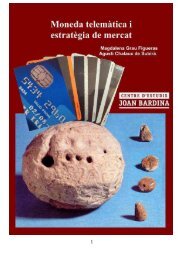Telematic currency and market strategy (mtemuk.pdf). - Centre d ...
Telematic currency and market strategy (mtemuk.pdf). - Centre d ...
Telematic currency and market strategy (mtemuk.pdf). - Centre d ...
Create successful ePaper yourself
Turn your PDF publications into a flip-book with our unique Google optimized e-Paper software.
Thanks to the possibility of emitting bank notes, the bases were set to avoid the shortage of precious metals,<br />
which even if new mines were discovered in the XIX century, were still insufficient. The XIX century is<br />
already fully industrialized: this produces a high increase of the needs of buying power at a rythm which<br />
precious metals cannot follow.<br />
7. The non-convertible bank note.<br />
Banks, thanks to bank notes, can issue higher amounts than the hard cash deposits. This<br />
is common practice, <strong>and</strong>, as we have already said, it causes no problems, as long as a<br />
reasonable ratio is held between metallic money <strong>and</strong> bank notes. Better still, this practice<br />
is absolutely necessary for the <strong>market</strong>, since through these mechanisms the necessary<br />
monetary instruments are produced when metallic money is insufficient.<br />
The money system based on the parallel circulation of metallic money <strong>and</strong> bank notes is<br />
currently called «gold st<strong>and</strong>ard». This system is a peculiarity of all the XIX century.<br />
In the end, also the «gold st<strong>and</strong>ard» became unsuitable for the needs of a <strong>market</strong> as developed as that of the<br />
XX century. With the new evolution of the money system, monetary instruments become completely<br />
abstract, completely foreign to any real <strong>and</strong> intrinsic value.<br />
During the XIX century, central banks of several states monopolized the emission of bank notes, which then<br />
became legal. But every time a State had political or economic problems -production crises, wars,<br />
revolutions...) <strong>and</strong> had more expenses, this State had to produce more <strong>and</strong> more bank notes, until the<br />
inevitable trust crisis arrived. Everybody wished to convert his notes in metal, <strong>and</strong> the only solution for the<br />
state was to declare a compulsory use of the notes, which meant it was impossible to convert them into<br />
precious metals. Only when the situation became normal again could convertibility be re-established.<br />
We must point out that an important forerunner of the inconvertible bank notes is to be found in the Law<br />
system (1716-1720), <strong>and</strong> in the «assignats» of the French Revolution.<br />
During World War I the enormous war expense almost completely emptied the chests of the participating<br />
states. Most of the gold from these states «emigrated» to the U.S.A. Banknotes were produced in great<br />
quantities <strong>and</strong>, of course, convertibility was suppressed.<br />
Since then, the money systems of the «civilized world» were distinguished by the inconvertibility of bank<br />
notes. After the war, some countries tried to reintroduce a partial convertibility, but the 1929 crisis definitely<br />
put an end to it.<br />
Therefore, the system born in World War I is based on the ab<strong>and</strong>onment of metallic money, as<br />
far as utilitarian relations are concerned. In international relations, the role of gold is held, but<br />
only until 1971, when president Nixon untied dollar from gold, <strong>and</strong> unilaterally denounced the<br />
treaty of Bretton Woods of 1944.<br />
The superiority of the inconvertible bank note, which we will simply call paper money, is the<br />
peculiarity of the new monetary stage. This paper money, which is still in use in our days, holds no<br />
relationship with gold nor with any metal nor real merch<strong>and</strong>ise. It does not represent any quantity of gold,<br />
<strong>and</strong> it cannot be converted into it.<br />
Which is then the nature of paper money? which is its basis? Paper money is simply based on the social<br />
agreement which has made it the necessary instrument of the mercantile exchanges <strong>and</strong> on the trust given it,<br />
as an instrument which fulfils its function adequately. Therefore its nature is radically auxiliary-abstract. Its<br />
value is that of an instrument helping us in accountancy <strong>and</strong> exchange of real goods; it has an auxiliary <strong>and</strong><br />
abstract value, <strong>and</strong> not an intrinsic <strong>and</strong> real value: this can only be a peculiarity of real goods.The money<br />
system has finally gone back to its fundamental primitive nature.<br />
24



